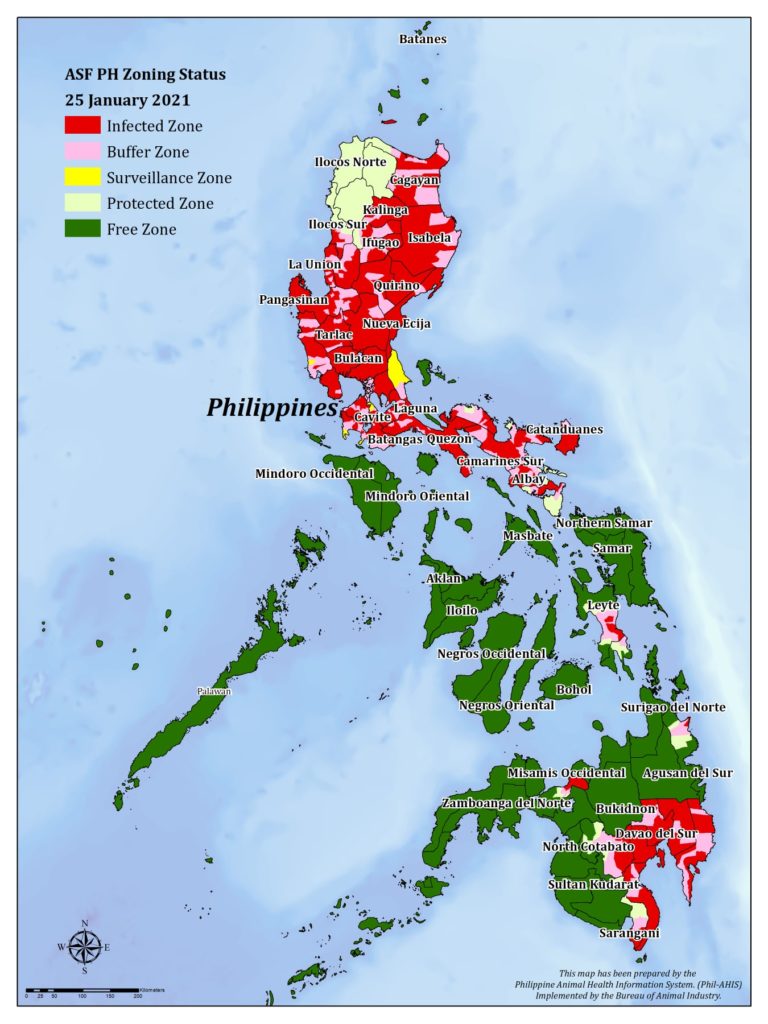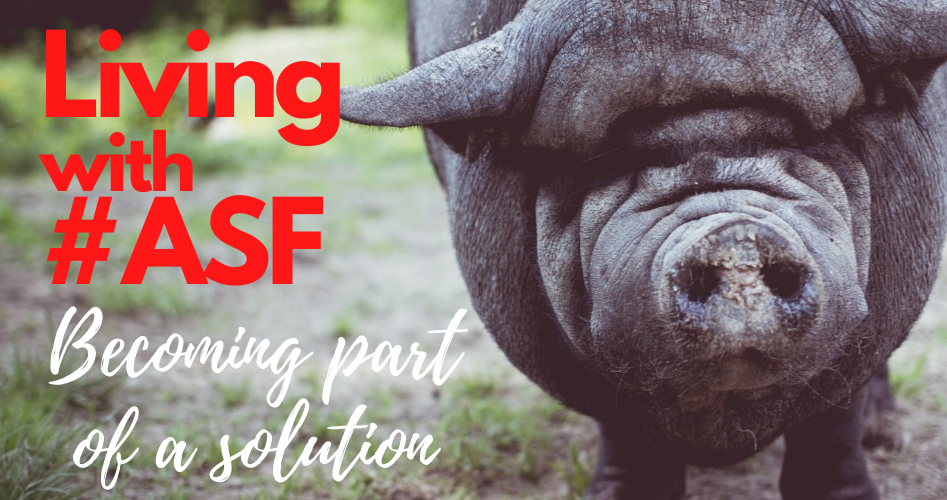The ASF in the foreground
A bit of ASF history
ASF has a bit long history, but just briefly, it was first described in Kenya in 1921, a massive outbreak occured in Portugal/Spain in the 1960s, South Ameican countries like Cuba, Dominican Republic and Brazil in the 80’s, and finally reached the Caucasus region in Georgia in 2007. Since then, the African Swine Fever virus (ASFV) had become unstoppable, infecting some countries in the European Union in 2014, and finally crossed China in the middle of 20181. In less than a year after, ASFV has been confirmed in many countries in Asia incuding The Philippines in August of 2019. Along the course of these outbreaks and devastations, ASF has resulted in several millions of pigs and billions of dollars lost, globally.
According to BAI-DA, to date at least 10 regions in the Philippines including 378 munipalities/cities covering more than 2,000 barangays have been confirmed of ASF, with the latest outbreak recorded in Abuyog, Leyte, the first case in Eastern Visayas (Region 8)2. Region 8, where Baybay City belongs, is located in the eastern seaboard of the country and serves as a major corridor for travel and commercial activities of people going to and coming from the northern and southern parts of the Philippines, largely via the Pan-Philippine Highway (AH 26), which passes through these islands, thus outbreaks like these cannot be overstated.

A closer look at the ASFV
The African Swine Fever virus (ASFV), is the only species of the genus Asfivirus of the family Asfarviridae that specifically affects the ‘pig family’ – both domestic and wild pigs. Due to its complexity, the virus is very LETHAL affecting all stages of pigs and can wipe out an entire pig farm in a short period of time. It is highly INFECTIOUS as the virus can be transmitted in essentially various composites like infected blood, feces, urine, fresh or frozen pork and meat products, semen, and products of putrefaction from dead/decaying pigs, among others. Moreover, since the virus is relatively stable against different pH and temperatures, ASFV is extremely CONTAGIOUS and contraction/infection is easily possible throuigh different physical/mechanical vectors i.e. farm visitors, contaminated trucks, swill feeding, etc. Not to forget, ASF is immensely EXTENSIVE/EXPANSIVE (refer to 3 for more information).
With no commerical vaccines being yet available, ASF is likely to stay for a long time and if people are not extra careful and cautious, the battle against ASF could yield a losing end.
Now on the ‘meat’ part – what can you do as producer and consumer?
So, as a pork consumer and producer, “how can we stop the spread of ASF?” This could be the million-dollar question that may not be easy to answer. However, in the context of transmission and disease epidemiology, ‘human action’ is likely the cue to control and prevention. As said previously and to reiterate: if people are not extra careful and cautious, the battle against ASF could yield a losing end.
Firstly, it is important to clarify that the causative agent of ASF is unlikely to be transmitted from pigs to humans due to its unique viral genome4. Our main concern, however, is that ASF can wipe out an entire pig population at an unprecedented rate in a very short time. While the impact of ASF on pig producers is related to the enormous loss of hard-earned money and its associated mental burden, at the level of consuming public, the impact of ASF is related to food security as a result of depleted pork supply and the accompanying domino effect to our economy5.
To put it simply, imagine paying at least a double price for your favorite pork cuts that are already expensive, or excluding pork meat from your weekly market because no one is selling pigs. In addition, you have to spend extra on other basic goods and commodities because our country is losing one of the big economic contributors – the pig industry.
As a consumer or pig producer, how can you contribute to solving this epidemic in pigs? The short answer is to be well informed and be responsible. Hence, our Q&A below attempts to provide answers to some basic questions about ASF and how to take action in the event of an outbreak.
You ask – we answer
Is it safe to eat pork meat and pork products in areas with an ASF outbreak?
- It is still safe to eat pork meat and pork products as long as they come from establishments/sources certified by the National Meat Inspection Service (NMIS) or with a compliant seal from the Food and Drug Administration in the case of processed products. It is not recommended to buy pork meat from pigs slaughtered in backyards or from any suspicious sources, such as home-delivered pork meat and pork products at a very cheap price. Meat derived from a sick animal is not safe for consumption irrespective of methods of cooking. Although the ASF virus cannot be transmitted to humans, ASF-sick pigs are predisposed to secondary infections caused by microorganisms that might be harmful to humans.
How can I contribute to avoiding the spread of ASF?
- One must be aware of the basic signs and symptoms of ASF for early disease recognition and reporting. When faced with a suspected ASF case, informing the authorities and not hiding the information to the Local ASF Task Force, which composed mainly of the City or Municipal Agriculture Office, City or Municipal Veterinary Office, Department of Agriculture Regional Field Office VIII, and other related agencies would be the best way to contribute in preventing the outbreak. Respecting and following mandates and orders of the national and local government with respect to the consumption and restriction of pork and pork products within the local borders and regions. Sharing Information Education Campaign (IEC) materials, in any kind of communication aspect, including social media, and building ASF awareness helps a lot to avoid ASF spreading.
How can I keep my piggery ASF-free?
Keeping your pig farm free from ASF relies on strict biosecurity. This means that you must follow a systematic preventive measure to avoid the entry of infection into your farm.
- Avoid swill feeding. Many ASF outbreaks in the past were associated with swill feeding or giving pigs with ‘pasaw’, ‘lawog’, or ‘lamaw’. Remember that the virus can survive in refrigerated pork meat and other pork products for months, and so if your swill feed contains such contaminated food scraps, it will trigger an outbreak in your farm.
- Avoid visiting pig farms, live animal markets, and slaughterhouses if your family and neighbor are raising pigs. The virus can be transmitted through your shoes, clothes, or any inanimate objects. It is also possible to acquire the virus from an empty pig pen or any places previously contaminated by infected pigs since the virus can survive in the environment for around 5 days at room temperature6. If possible, inhibit any visitor from entering your piggery, including the salesperson of animal feed/products and personnel from other pig farms.
- Install fencing and footbaths as possible. For backyard raisers, it is important to isolate your pig farm or pig pens from humans and animals (e.g., dogs) by installing a corral. At the entry point of your farm, you may install a succession footbatha to kill any potential virus attached to your shoes or slippers before entering. For example, first, step into the plastic container with water to remove any soil from your shoes/slippers. Then, step into the second container containing the disinfectant. Lastly, step into the drying material.
- Clean and disinfect (C&D). Cleaning and disinfection should come together to effectively eliminate possible ASF virus and other pathogenic microorganisms in the pig farm. Cleaning can be done by first soaking for two hours all of your equipment (whenever applicable), ceiling, wall, and floor, followed by wet cleaning using detergent and water. Rub the area with a metal brush or sturdy plastic brush, particularly those floors and walls with irregular surfaces. The mixture of detergent and water should be foamy and in contact with surfaces for 20-60 minutes. After cleaning, wash with water, dry completely, and apply the disinfectant to surfaces. Disinfectants containing glutaraldehyde, 1% formaldehyde, 0.03-0.0075% sodium hypochlorite, 1% sodium or calcium hydroxide, and phenols may be used and it must be properly explained before use by an authorized person (e.g., veterinarian)7. Regular cleaning should be done daily while C&D may be done weekly.
- Dispose pig manure and urine properly. Do not use the river, lake, or sea as a septic tank of your pig farm. The long-distance spread of the ASF virus from one farm to another is associated with the improper disposal of pig wastes. You may bury the pig manure into a pit and add lye or caustic soda as a disinfectant.
Can I give antibiotics and supplements to my pigs to avoid an ASF outbreak?
- There is no proven benefit of giving antibiotics and supplements to pigs as a form of ASF prevention. Biosecurity and good animal husbandry are the best methods to preclude any potential ASF outbreak.
How do I know if my pig farm is affected by ASF?
- You will notice a sudden death of pigs of considerable percentage in your farm within 2 weeks. Clinical signs will likely include fever, lethargy, reddening of the skin, vomiting, diarrhea, and nosebleed.
What will I do if my pig farm is affected by ASF?
Report immediately to the City or Municipal Agriculture office.
- Do not conceal information that may delay the reporting. In ASF, no medicine can save your pigs, and reporting later because you want to treat them first is highly discouraged. Early reporting is essential to curb the spread of the virus.
- Do not perform emergency slaughter to sell your pigs in an attempt to recover a meager income. This behavior will trigger the spread of ASF thereby worsening your future financial burden.
- Coordinate with the local authority for proper disposal of dead pigs and other biosecurity protocols.
What about the government’s course of action when there is an ASF outbreak in my community?
- In general, the current national protocol for stopping the spread of ASF is anchored through quarantine and biosecurity, strict restrictions of pig movements, and slaughter of infected/exposed animals and proper disposal of dead pigs1. The protocol applies geographical zoning to classify the action to be taken for disease control. On this zoning strategy, the suspect premise is where the ASF outbreak started. The infected zone is the 1-km radius area from the suspect premise in which limited human/animal mobility is imposed and a mandatory test and slaughter of pigs are employed. The quarantine zone is the area where animal and human mobility are limited. The surveillance zone is the area where active monitoring and early ASF detection are conducted. Further details of this zoning strategy can be found on the African Swine Fever (ASF) Portal of the Bureau of Animal Industry (BAI) and should be coordinated with your Local Government Unit (LGU).
- ASF-affected pig farmers should also coordinate with your LGU and avail of the indemnification cash assistance organized by the Department of Agricutlure which provides Php 5,000.00 per pig culled. This program should somehow encourage pig farmers to cooperate and report any potentail ASF outbreaks. More information about the indeminification fund including a credit window for ASF-affected farmers can be found here.
- Cooperate and get your pigs tested.
When can I start raising pigs again?
- When there are no cases of ASF or as recommended by the ASF task force after thorough decontamination and disinfection of your farm, you will be allowed to restock to a certain capacity of your farm as sentinel animals, which will be under observation daily for several weeks. After that, restocking at full capacity may be allowed when no clinical ASF is detected.
What can I do to recover and prevent future financial losses from ASF?
- The Department of Agriculture-Philippine Crop Insurance Corporation encourages all farmers to apply for livestock insurance so that farmers can bounce back from the financial burden they incur during the outbreak. You can ask your City/Municipal Agricultural Office or the Department of Agriculture Regional Field Office VIII. For more information visit the DA-PCIC website: https://pcic.gov.ph/livestock-insurance/.
Finally, what CVM-VSU is doing?
The College of Veterinary Medicine, Visayas State University is committed to be part of the solution in combating African Swine Fever in our locality. The college has started to ramp up its information campaigns through ASF Forums and Q&A’s in various media both online and on-air to educate and guide our stakeholders. In September 2020, CVM-VSU conducted an ASF Briefer among Barangay Animal Health Workers (BAHWs), an activity that was organized collaboratively by the ATI-RTC8 and the LGU of Baybay City. This was followed in October 2020 when CVM-VSU hosted the 1st virtual Pinoy Pork Challenge Roadshow 2020 sponsored by the Philippine College of Swine Practitioners (PCSP). In coordination with the LGU of Baybay City, the ATI-RTC8, DA-BAI, and PCSP, among others, we stand with our community in protecting and safeguarding our local pig industry and the interest of the public.
References and Resources:
-
Sánchez‐Vizcaíno, J. M., Mur, L., & Martínez‐López, B. (2012). African swine fever: an epidemiological update. Transboundary and emerging diseases, 59, 27-35.
-
Sabalza, G. (2021). E. Visayas’ first ASF case confirmed in Leyte town. Philippine News Agency. https://www.pna.gov.ph/articles/1127561.
-
Sánchez-Cordón, P. J., Montoya, M., Reis, A. L., & Dixon, L. K. (2018). African swine fever: A re-emerging viral disease threatening the global pig industry. Veterinary journal (London, England : 1997), 233, 41–48. https://doi.org/10.1016/j.tvjl.2017.12.025.
-
Dixon, L. K., Stahl, K., Jori, F., Vial, L., & Pfeiffer, D. U. (2020). African swine fever epidemiology and control. Annual review of animal biosciences, 8, 221-246.
-
Godfray, H., Mason-D’Croz, D., Willenbockel, D., Bogard, J. R., Sulser, T. B., Robinson, S., … & Wiebe, K. Modelling the global economic consequences of a major African swine fever outbreak in China. Nature Food.
-
Mazur-Panasiuk, N., Żmudzki, J., & Woźniakowski, G. (2019). African swine fever virus–persistence in different environmental conditions and the possibility of its indirect transmission. Journal of veterinary research, 63(3), 303-310.
-
Laura, B., Loris, A. G., Jasna, P. R., Marina, Š., & Silvia, B. (2020). African swine fever: A review of cleaning and disinfection procedures in commercial pig holdings. Research in Veterinary Science.
Featured image by Free-Photos from Pixabay.
Originally published on 23 January 2021 | This special article was written by: Santiago T. Peña, Jr., DVM, PhD, Diplomate, Philippine College of Swine Practitioners and Harvie P. Portugaliza, DVM, PhD; reviewed by Eugene B. Lañada, DVM, MPhil, Fellow, Philippine College of Veterinary Epidemiologists.






